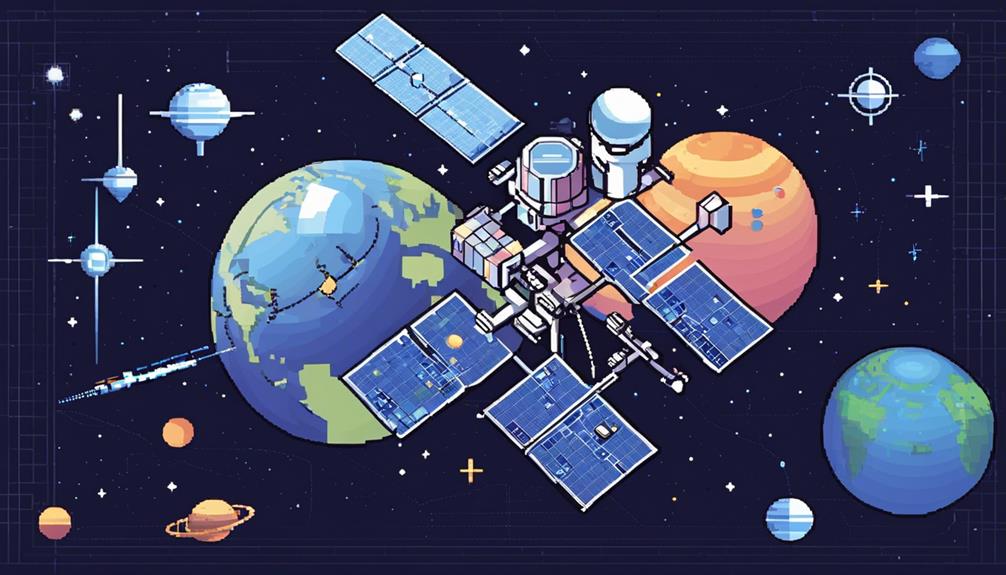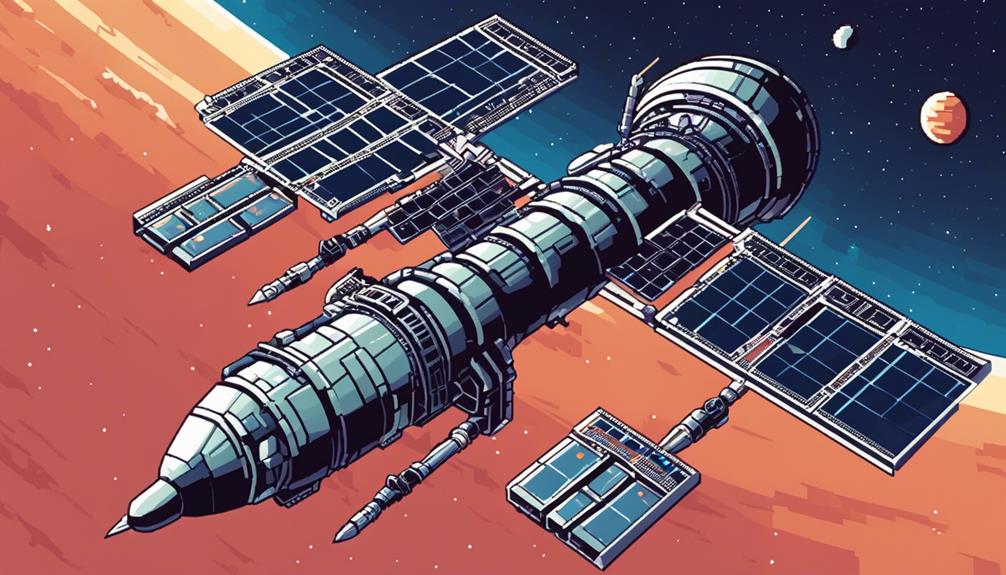Exploring the realm of Intellectual Property Rights (IPR) in space technology unveils a complex web of legal considerations and challenges. As advancements in space exploration and commercialization accelerate, the need to protect innovations and creations in this domain becomes increasingly pressing. The interplay between traditional intellectual property frameworks and the unique characteristics of space activities raises intriguing questions about ownership, enforcement, and international cooperation. Delving deeper into the intricacies of IPR in space technology promises to shed light on the evolving landscape of innovation and protection beyond our terrestrial boundaries.
Key Takeaways
- Patents, copyrights, trademarks protect space innovations.
- Legal frameworks tackle jurisdictional challenges in space IP.
- Future trends require international treaties for harmonization.
- Coherent enforcement mechanisms safeguard space tech innovation.
What Are Intellectual Property Rights?

Intellectual property rights in the realm of space technology encompass legal protections for the innovative creations of the human intellect within this specialized field. In the context of space technology, these rights play a crucial role in fostering innovation, incentivizing research and development, and ensuring a fair return on investment for individuals and organizations involved in this sector. Patents, copyrights, and trademarks are the primary forms of intellectual property rights that are utilized to safeguard various aspects of space technology.
Patents are particularly significant in space technology as they protect new inventions and processes that are deemed to be novel, non-obvious, and useful. In the space industry, patents are often sought for groundbreaking technologies such as propulsion systems, satellite designs, and communication protocols. Copyrights, on the other hand, safeguard original works of authorship, including software code, technical manuals, and artistic designs related to space technology.
Trademarks are crucial for identifying and distinguishing the goods and services offered within the space technology domain. They help prevent confusion among consumers and protect the reputation and branding of organizations involved in space-related activities. By securing patents, copyrights, and trademarks, entities like the European Space Agency (ESA) can safeguard their intellectual property assets, maintain a competitive edge in the market, and ensure that their innovations are recognized and respected within the space technology sector.
ESAs IPR Policy Overview
ESA's IPR policy provides guidelines on technology ownership, licensing, and agreements within the organization. These rules ensure that inventions and creations are appropriately declared and exploited by staff members while safeguarding intellectual property rights. By adhering to ESA's IPR guidelines, staff members can benefit from fair returns on their innovations and contribute to the organization's overall creativity and innovation.
Esa's IPR Guidelines
Esa has implemented comprehensive Intellectual Property Rights (IPR) guidelines to regulate the management and utilization of inventions and creations generated by its staff members. These guidelines ensure proper declaration and exploitation of intellectual property in line with ESA's policies. Compliance with these guidelines is crucial for staff engaged in space technology innovation. The aim of ESA's IPR policy is to protect and leverage the intellectual property contributions of its staff members efficiently. To achieve this goal, the guidelines focus on promoting innovation, ensuring a fair return on investments, and encouraging the disclosure of intellectual property to the public.
- Proper declaration and exploitation of intellectual property
- Essential compliance for staff involved in space technology innovation
- Protection and leveraging of staff members' intellectual property contributions
- Promotion of innovation, fair return on investments, and public disclosure of intellectual property
Technology Ownership Rules
Within the framework of the organization's Intellectual Property Rights (IPR) policy, the rules governing technology ownership and exploitation at ESA are designed to safeguard innovations, foster creativity, and ensure equitable returns on investments. These rules encompass various aspects such as patents, copyrights, and trademarks for space technologies and innovations developed within ESA. Staff members are obligated to disclose and manage their inventions following ESA's IPR policies to guarantee compliance and protection of intellectual property rights. Adherence to these regulations is crucial for maintaining the integrity of inventions and ensuring that creators receive appropriate recognition and benefits. The IPR framework at ESA plays a pivotal role in shaping how technology ownership is structured and managed within the organization.
| Aspect | Description | Importance |
|---|---|---|
| Patents | Protect novel inventions and technologies developed at ESA | Ensures innovation |
| Copyrights | Safeguard original works of authorship in space technology | Preserves creativity |
| Trademarks | Identify and distinguish goods and services related to space tech | Ensures brand integrity |
Licensing and Agreements
Licensing and agreements play a critical role in the strategic management of intellectual property rights within the domain of space technology, ensuring the proper utilization and commercialization of ESA's innovations.
- Licensing agreements facilitate the exploitation of ESA's inventions.
- Agreements with external parties are crucial for the commercialization of ESA's technology.
- ESA's IPR policy guides the procedures for licensing technology.
- Fair compensation and proper utilization of intellectual property assets are ensured through licensing agreements.
Forms of Intellectual Property in Space
In the realm of space technology, forms of intellectual property play a crucial role in safeguarding innovations. Patents are instrumental in providing exclusive rights to inventions developed for space programs, while copyrights protect authors' rights in space activities such as satellite data transmission. Trademarks, on the other hand, serve to distinguish and secure exploitation rights for products and services originating from space-related innovations.
Patents for Space Tech
Patents play a crucial role in safeguarding the exclusive rights to innovative space technologies developed for space exploration, covering a wide range of advancements such as propulsion systems, satellite technology, and space vehicle designs.
- Patents for space technology grant exclusive rights to inventions developed for space exploration.
- They cover innovations like propulsion systems, satellite technology, and space vehicle designs.
- Patents ensure inventors have the sole right to use, sell, and license their space-related inventions.
- Space agencies like ESA file patents to protect their technological advancements in space programs.
Copyrights in Space
Copyrights in space technology play a pivotal role in protecting the economic and moral rights of authors and creators involved in satellite transmissions and remote-sensing data. Copyright protection extends to satellite data utilized for commercial purposes, ensuring fair compensation and recognition for creators. Authors engaged in space activities benefit from copyright laws that safeguard their economic interests and moral rights. The European Space Agency (ESA) is instrumental in ensuring that copyrights are respected within space programs and innovations. By upholding copyright protection in space, creators are encouraged to continue producing valuable content while receiving the deserved benefits from their intellectual property. Fair compensation mechanisms embedded in copyright laws contribute to fostering innovation and creativity within the space industry.
Trademarks Beyond Earth
How do trademarks in the realm of space technology serve to distinguish and protect intellectual property rights in the vast expanse beyond Earth? Trademarks play a critical role in protecting intellectual property rights in space, especially for space programs and innovations. Here are some key points to consider:
- Trademarks in space help distinguish products and services, granting exclusive exploitation rights.
- Entities like the European Space Agency (ESA) file trademarks to protect their branding in the space industry.
- Trademarks are essential for identifying space-related goods and services beyond Earth's boundaries.
- Harmonization of trademark laws ensures consistent protection across EU member states, providing a unified approach to safeguarding trademarks in space activities.
Applying Copyrights in Space Technology
In the realm of space technology, the application of copyright protections is a crucial aspect that safeguards original works like software codes, satellite images, and scientific data. Authors and creators of space technology benefit from both economic and moral rights under copyright law. Copyrights serve as a vital tool in preventing unauthorized use or reproduction of innovations in space technology. Licensing agreements play a significant role in granting permission for the use of copyrighted materials within the space technology sector. Infringement of copyright in space technology can lead to severe legal repercussions and financial consequences for the violators.
| Copyright Protection in Space Technology | |
|---|---|
| Extent | Original works such as software codes, satellite images, and scientific data |
| Rights | Economic and moral rights for authors and creators |
| Safeguard | Against unauthorized use or reproduction of space technology innovations |
| Licensing Agreements | Crucial in granting permission for the use of copyrighted materials in space technology |
| Consequences | Copyright infringement can lead to legal repercussions and financial consequences for the violators |
Patents in Space Innovation

Patents in space innovation play a pivotal role in protecting and incentivizing inventors by granting exclusive rights for their novel technological advancements in the realm of space technology. Space patents are instrumental in safeguarding intellectual property rights related to innovative space technologies. Here are some essential points to consider regarding patents in the context of space innovation:
- Novelty, Inventiveness, and Industrial Applicability: Space patents, like any other patents, necessitate meeting specific criteria such as novelty, inventiveness, and industrial applicability to qualify for protection.
- Encouragement of Innovation and Investment: Patent protection in space technology serves as a catalyst for fostering innovation, attracting investment, and propelling the development of cutting-edge space systems.
- Role of Space Agencies: Space agencies such as NASA and ESA actively engage in patent filings to secure their groundbreaking space technologies, ensuring their exclusive rights over these innovations.
- Technological Advancement and Commercialization: Patents in space innovation not only drive technological progress but also facilitate the commercialization of space-related inventions, promoting international collaboration within the space sector.
Challenges in Space IP Protection
Protecting intellectual property rights in the realm of space technology poses intricate challenges due to the lack of specified jurisdiction and the unique nature of space operations. Applying conventional IP regulations to space innovation introduces uncertainties, emphasizing the necessity for tailored legal frameworks. The absence of clear guidelines for enforcing IP rights in space adds complexity to addressing infringements and necessitates innovative legal strategies to navigate this uncharted territory.
Patenting Space Innovations
Challenges inherent in safeguarding intellectual property rights for space innovations stem from the unique jurisdictional complexities and borderless nature of the space environment. When it comes to patenting space innovations, several hurdles arise, including the jurisdictional ambiguity that complicates enforcement efforts. Additionally, the criteria for patent protection, such as proving originality, novelty, and benefit to humankind, must be met, which can be challenging in the context of space technologies. Moreover, adapting terrestrial intellectual property laws to the space environment, as mandated by the Outer Space Treaty's Article VIII, presents further obstacles. Navigating these challenges requires a nuanced understanding of intellectual property rights and the legal frameworks governing space activities.
Global IP Regulations
Given the intricate interplay between international treaties and the inherent clash of legal philosophies in outer space, navigating the realm of global intellectual property regulations presents a formidable challenge in ensuring robust protection for space innovations. International treaties lack explicit provisions on intellectual property protection in outer space, leading to legal uncertainties. Theoretical clashes exist between outer space law emphasizing the public domain and IP law focusing on private rights. Enforcing IP rights in space poses unique challenges due to the absence of traditional borders and jurisdictional ambiguity. The Outer Space Treaty of 1967 reconciles territoriality conflicts to ensure intellectual property protection in outer space. Legal frameworks for intellectual property rights in space need to address complexities like enforcement, jurisdiction, and harmonization across nations.
| Challenges | Description | Solutions |
|---|---|---|
| Legal uncertainties | Lack of explicit IP laws in international treaties leads to ambiguity in space IP protection. | Establish clear guidelines for IP protection in outer space. |
| Jurisdictional issues | Difficulty in enforcing IP rights in space due to the absence of traditional borders. | Develop a framework for determining jurisdiction in space intellectual property. |
| Harmonization efforts | Need for aligning IP laws across nations to ensure consistent protection for space innovations. | Establish international agreements for harmonizing space IP regulations. |
International IP Framework for Space

The establishment of an international intellectual property (IP) framework specifically tailored for space endeavors is crucial for ensuring the harmonization and protection of intellectual property rights in the realm of space technology. In the context of international cooperation and the legal framework governing space activities, the following key points highlight the significance of an International IP Framework for Space:
- Harmonization for Consistent Protection: International IP frameworks help harmonize laws to ensure consistent protection of Intellectual Property Rights (IPRs) across different countries involved in space activities.
- European Partner States' Obligations: European Partner States are required to establish IPR provisions at the national level that are compatible with international agreements like the International Space Station Intergovernmental Agreement (IGA).
- Impact of Ratification: Ratification of agreements such as the IGA by European States directly impacts the implementation of IP provisions, with entry into force for European Partners contingent on contributing States' ratification.
- Legal Compliance and Enforcement: An international IP framework provides a basis for legally compliant practices and enforcement mechanisms concerning intellectual property protection in the context of space technology development and utilization.
This framework plays a crucial role in fostering innovation, protecting investments, and promoting cooperation in the field of space technology while ensuring that intellectual property rights are safeguarded effectively on a global scale.
Trade Secrets in Space Tech
Trade secrets play a pivotal role in safeguarding confidential information essential to the competitive edge and security of space technology advancements. In the realm of space technology, trade secrets encompass a wide array of confidential information ranging from spacecraft designs and propulsion systems to mission plans and operational procedures. The protection of trade secrets within the space tech industry is crucial for maintaining competitive advantages and preventing unauthorized use or disclosure, which could result in economic losses and compromised missions.
Companies operating in the space sector employ various strategies to safeguard their trade secrets. These measures include the implementation of non-disclosure agreements, restricted access to sensitive information, and the use of robust cybersecurity protocols. Additionally, trade secrets in space technology may involve proprietary algorithms, manufacturing processes, and other critical intellectual property assets that provide significant value to their owners.
Unauthorized access to trade secrets in the realm of space technology can have severe consequences, leading to potential legal disputes over intellectual property rights, compromised technological advancements, and financial setbacks. Therefore, maintaining the confidentiality and protection of trade secrets is paramount for companies seeking to innovate and thrive in the competitive landscape of the space industry.
Future of Space IP Regulation

Safeguarding the confidentiality and protection of intellectual property rights in space technology is evolving towards addressing jurisdictional challenges through potential international treaties, emphasizing the need for clear frameworks and harmonization of laws to support commercial space activities. As the space industry expands, the future of space IP regulation is becoming increasingly pertinent. Here are some key considerations shaping the landscape:
- International Treaties: Future space IP regulation may require the establishment of international treaties to navigate jurisdictional challenges that arise in the context of space activities.
- Clear Frameworks: Developing clear frameworks for intellectual property protection in outer space is crucial to ensure the rights of innovators and creators are upheld.
- Harmonization of Laws: The harmonization of laws across nations is essential to ensure consistent regulation of intellectual property rights in space and foster a conducive environment for innovation.
- Innovative Solutions: Creative approaches such as private licensing agreements could play a significant role in shaping the future of space IP regulation, offering new avenues for protecting intellectual property in the outer space domain.
Resolving legal uncertainties around IP protection in space will be fundamental in attracting investment and driving innovation in the space sector, ultimately contributing to the sustainable growth of space technology.
Enforcement of Space IP Rights
Enforcement of intellectual property (IP) rights in space poses distinct challenges due to the unique nature of the domain and the absence of traditional boundaries. The legal framework for enforcing IP rights in space is not as well-defined as it is on Earth, leading to practical difficulties in enforcing judgments and preventing unauthorized technology use across borders. Addressing violations of IP laws in space requires an innovative approach due to the complexities involved in determining applicable laws and jurisdiction for disputes.
The enforcement of IP rights in space necessitates a robust legal framework that can adapt to the evolving landscape of space exploration. Jurisdictional issues further complicate matters, as determining which laws apply to disputes that transcend international borders is a multifaceted process. Without a clear framework in place, enforcing IP rights becomes a challenging task that requires innovative solutions.
To effectively enforce IP rights in space, stakeholders must work towards establishing a coherent legal framework that addresses the unique challenges presented by the domain. This framework should incorporate innovative mechanisms to resolve disputes and prevent violations effectively. As space exploration continues to advance, the development of a comprehensive legal framework for enforcing IP rights will be imperative in protecting innovation and fostering technological advancement in the space industry.
Frequently Asked Questions
What Is the Intellectual Property of Technology?
Intellectual property of technology encompasses various legal protections such as patent protection, copyright laws, and trade secrets. These mechanisms safeguard innovations, creative works, and proprietary information from unauthorized use. They grant innovation rights to creators, enabling them to maintain technology ownership and commercialize their inventions. Licensing agreements play a crucial role in granting permission for the use of intellectual property, ensuring that creators benefit from their innovations while controlling their dissemination.
What Is the IPR in Space Law?
In the realm of space law, Intellectual Property Rights (IPR) pertain to the protection and enforcement of rights over innovations and creations related to space activities. This includes patent protection for space mining technologies, trademark registration for satellite designs, and copyright laws governing lunar exploration discoveries. The complex international landscape of space exploration necessitates robust legal frameworks to address IPR issues in the development of space technology.
What Is IPR in Cyber Space?
Intellectual Property Rights in cyberspace pertain to the legal framework governing ownership and protection of digital assets, encompassing copyright protection, technology patents, and trade secrets. Cyber security measures are crucial in safeguarding digital innovation and data privacy, mitigating threats like online piracy and unauthorized use. The enforcement of IPR in cyberspace involves addressing infringement issues through legal mechanisms to uphold creators' exclusive rights to their digital creations, fostering a conducive environment for innovation.
What Are the Rights of Intellectual Property for Inventions?
When considering the rights of intellectual property for inventions, it is imperative to acknowledge the significance of patent protection, copyright laws, trade secrets, and innovation rights. Through licensing agreements, creators can secure their intellectual property, while infringement cases serve to uphold these rights. Safeguarding innovations through legal frameworks ensures creators benefit from their inventions and encourages continued advancements in various sectors.
